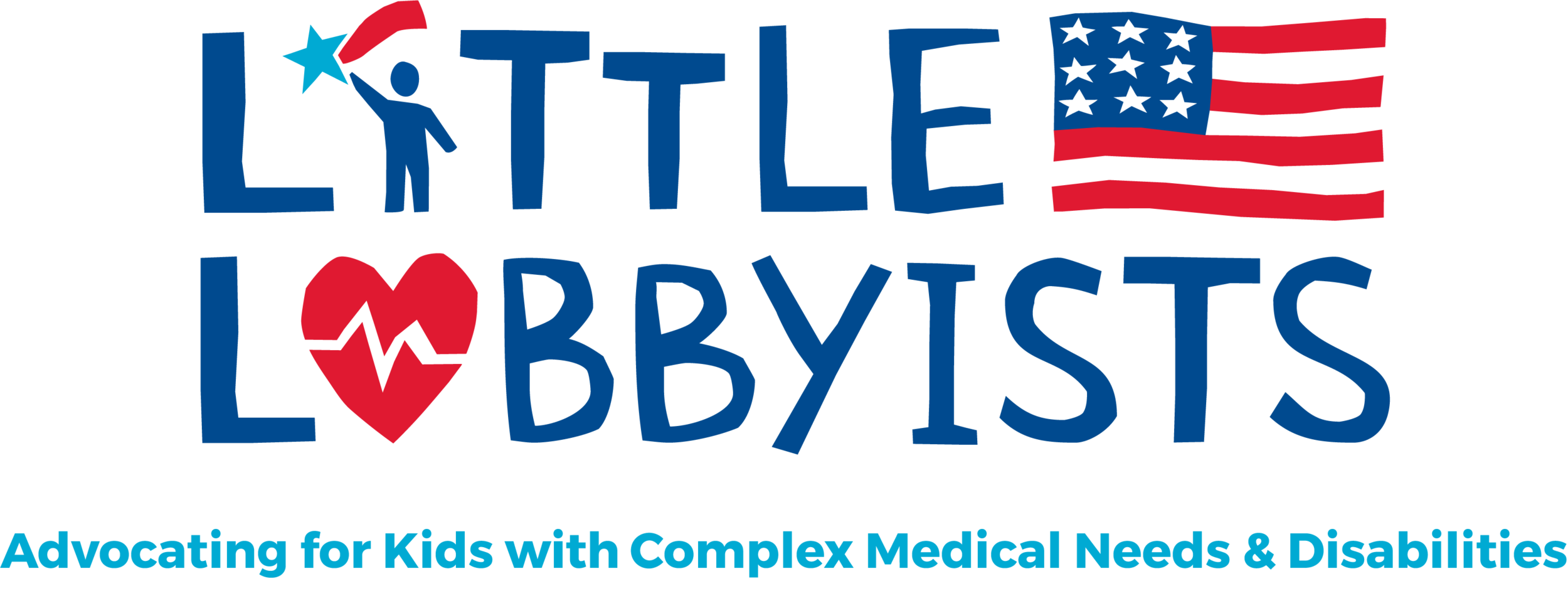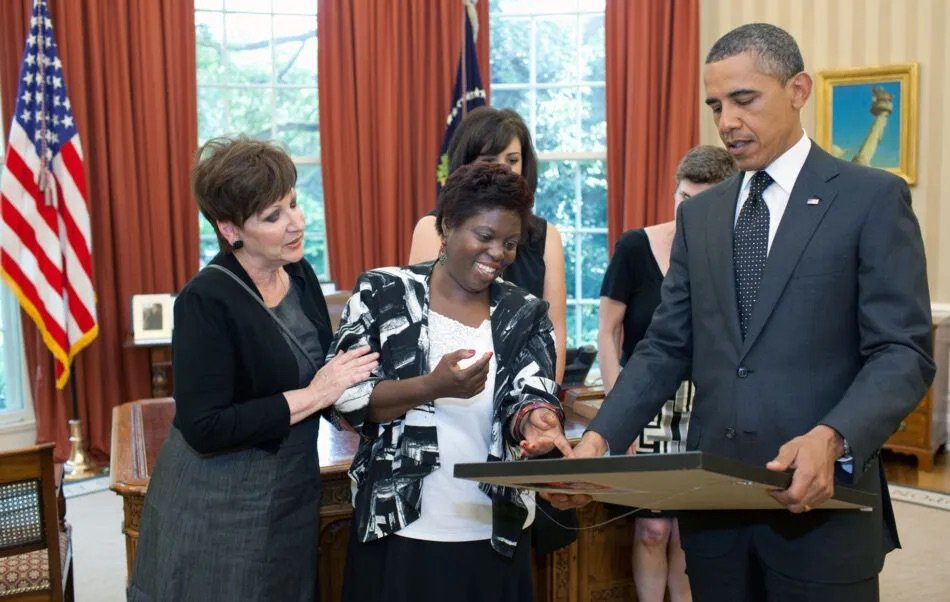Know Your Rights: The Olmstead Decision (by Jeneva Stone & Laura LeBrun Hatcher)
Little Lobbyist James McLelland (c) and his mom Jeni (r) are seated at a long table with a royal blue cover, with a moderator to the left. They are on a stage in the Great Hall of the U.S. Department of Justice. Behind them is an American flag, a Justice Department flag, and a Health and Human Services flag. Above these is the U.S. Department of Justice seal with an eagle. On the far left is a large silver metal statue of Lady Justice, wearing a toga and holding up both arms.
The U.S. Supreme Court’s Olmstead Decision, a landmark civil rights case for people with disabilities, marks its 25th anniversary this year! In 1999, the Court upheld the right to community integration in the Americans with Disabilities Act (ADA) of 1990. Our disabled loved ones have the right to live and thrive in their homes and communities, where they belong. Home care is a human right.
To honor the 25th Anniversary of the Olmstead Decision, the Biden Administration held multiple events. On Tuesday, the White House hosted a screening of the short film, Take Me Home, by director Liz Sargent starring her sister Anna, an actress with cognitive disabilities, followed by a discussion with advocates and top members of the Administration about the importance and challenges of community living,and how people with disabilities are part of making positive change. Later in the week, the Departments of Justice and Health and Human Services held a joint celebration that included remarks and panel discussions with leading officials and disabled advocates–including Little Lobbyists James and his mom Jenny McLelland–on the significance of Olmstead and on the Biden Administration’s work to make sure every person with disabilities has the right to live in their own community.
Disabled activist Emmanuel Jenkins, Vice Chair and Community Relations Officer for the Delaware Developmental Disabilities Council, had this to say: “Without the Olmstead Decision, I would not be sitting in the White House … without that decision I would not be able to work a full-time job … I would not have just celebrated 15 years of marriage … without that decision, I would not be able to elevate that voice [those of people with disabilities].”
Little Lobbyists James, age 13, from California said: “I’m proud to be disabled. It’s part of who I am. … Olmstead means I have a nurse who goes to school with me to make sure I keep breathing while I’m in class … who comes to my house at night to manage the ventilator to keep me breathing. Being disabled means that I have to rely on other people – it’s okay to rely on other people for care. I’m here today because I’m an Olmstead success story – I’m getting the care I need to live my life the way I want to live it. I want to make sure that other disabled people have the same access to the community that I do.”
What was the Olmstead Case About?
Olmstead vs. L.C. & E.W. was brought by two disabled women, Lois Curtis and Elaine Wilson, against the State of Georgia and its commissioner of the Department of Human Resources, Tommy Olmstead. Lois and Elaine had been repeatedly institutionalized, and their suit argued that this was unjustified segregation and discrimination under Title II of the ADA. Lois was the driving force behind the case, repeatedly contacting the Atlanta Legal Aid Society to ask for their help, and in 1995, it agreed.
Photo Credit: Official White House photo by Pete Souza. [image description: Lois Curtis (center) presents President Barak Obama (r) with one of her paintings. To the left of Lois is her direct support professional. They are in the Oval Office.]
In 1999, the Supreme Court sided with Lois, agreeing that “people with disabilities […] have the right to receive the treatment they need in an integrated setting if that is what they want, if their doctors agree, and if it doesn’t fundamentally change how the state provides services to people with disabilities.” According to all accounts of her life, Lois Curtis thrived outside of the institutions that had once oppressed her. She became a well-known artist with a talent for portraiture.
What is the “right to community integration”?
Disabled people have been fighting for their community living rights throughout U.S. history, for the right to stay out of institutions, facilities, and asylums. Medicaid itself did not allow in-home care until 1983 when Katie Beckett’s situation caused Congress to finally establish the first HCBS waiver. The ADA of 1990 established community living rights under Title II: “The ADA bans the unnecessary segregation of people with disabilities in a regulation called ‘the integration mandate.’ As a result, State and local governments that provide services to people with disabilities must offer those services in people’s homes and communities—not just in institutions.”
What does this mean for my family?
Under federal law, Medicaid’s HCBS waivers are still considered “optional” services for states, and states continue to make it difficult for disabled people to live in their communities, but progress is on our side. Given the high costs of institutionalization, states are expanding their offerings and beginning to reduce long waiting lists. The American Rescue Plan of 2021 provided additional funding for HCBS, and, as of last year, states have committed approximately $37 billion to such programs. All 50 states now have Katie Beckett waivers for minor children to live at home.
Little Lobbyist Rob Stone, seated in his wheelchair and wearing his trademark Clark Kent glasses, smiles at the Olmstead White House event. He poses in a doorway with the blue oval seal of the White House and an American flag behind him on a yellow wall.
Many families, though, first qualify for HCBS as their disabled loved ones transition from high school to adult services. While this transition can be emotional and difficult, remember that you or your disabled loved one have the right to live in your community in the most integrated setting appropriate to your needs. If transition coordinators propose something that isn’t right for you or your dependent adult, ask hard questions. Often, school systems will present transition as if entitlements end with high school graduation; however, civil rights are also an entitlement. Remind them of that. Ask about HCBS “self-directed services,” a good option for many people.
There are 56 State Councils on Developmental Disabilities. Reach out to yours with questions and concerns. The National Association of Councils on Developmental Disabilities (NACDD) has many resources, including tips for advocacy.
And never give up. As former congressman Tony Coelho–the principal author of the ADA, and a person with a disability–said at the White House, “My philosophy in life is this: give me the right to fail. But in order to do that, give me the opportunity to succeed. And that’s what we all want–nothing more, nothing less. But we want that opportunity to succeed. And we only get that opportunity if all of you in this room work to make it happen. We did not get Olmstead, we did not get the ADA on our own. We got the ADA because of all of you and the rest of us all over the country who have disabilities.”
What’s Being Done to Ensure My Rights?
Olmstead marks the beginning of enforcement of community living rights for disabled people and the expansion of Medicaid’s Home and Community-Based Services (HCBS) waivers. Since 1999, states have made progress on HCBS: These supports include aides and other staff, job assistance and coaching, medical care, housing options, and funds for equipment and activities. But we have a long way to go.
Disabled advocates and members of the administration agree that there’s a lot more work that needs to be done to fulfill the promise of Olmstead and ensure all people with disabilities can access their civil right to get the care they need in their own homes and communities.
On the first day of his administration, President Biden mandated that his Administration would be focused on equity. The President has made it clear that he wants to work with Congress to provide the funding needed to end Medicaid waiting lists for home and community-based services—a priority he made a “down payment” on with an investment of $37 billion from the American Rescue Plan.
In addition to funding, the Administration has taken many actions to expand and improve the rights of people with disabilities. Some of these actions include:
Multiple Executive Actions to improve equity and access to care, including an Executive Order on Diversity, Equity, Inclusion, and Accessibility in the Federal Workforce, and a set of sweeping Executive Actions to Improve Care
Department of Transportation established the Airline Passengers with Disabilities Bill of Rights, created new rules for how airlines handle wheelchairs and to make airplane bathrooms accessible, and provided $1.75 billion for states to make public transit stations accessible
The Department of Justice established a new strike force to enforce Olmstead and expedite case resolution that has helped 500+ adults and children in every state
Established the Direct Care Workforce Strategies Center and actions to address the care workforce crisis
Invested $212 Million to Expand Affordable Housing Options for Persons with Disabilities
You can find additional resources and learn more about the actions the Biden Administration has taken to enforce Olmstead and expand access to community living for all people with disabilities using the links below:
From the Department of Justice Civil Rights Division:
https://www.ada.gov/topics/community-integration/From the Department of Health and Human Services:
https://www.hhs.gov/civil-rights/for-individuals/special-topics/community-living-and-olmstead/index.htmlFrom the Administration for Community Living:
https://acl.gov/news-and-events/events-and-observances/olmstead-anniversary
Preview video of TAKE ME HOME: Anna peeks around a doorway in her home. Video includes links to purchase the short film.
Jeneva Stone is the Little Lobbyyists blog manager, and Laura Hatcher is the Little Lobbyists Communications Director.



